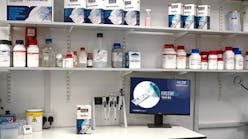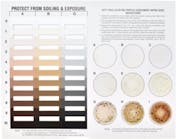Providing clean, dry fuel to aircraft is perhaps the most important ground handling task performed by fixed base operators (FBOs). Being able to carry out this duty while reducing harmful emissions sounds like a win-win situation.
However, when these two initiatives became inadvertently intertwined, the aviation industry narrowly avoided catastrophe.
As a result, the general aviation community has come together to take steps that ensure future potential for diesel exhaust fluid (DEF) contamination of aircraft fuel is mitigated.
What is DEF?
According to the Diesel Technology Forum, diesel-powered ground support equipment (GSE) began utilizing diesel emissions control systems more prevalently in 2014 in order to reduce emissions and improve air quality for ground service providers.
These modern GSE units deploy Selective Catalytic Reduction (SCR) systems that allow the equipment to produce nearly zero emissions and meet emission standards put in place by the U.S. Environmental Protection Agency (EPA).
John Fischer, an engine consultant based in Illinois, explains that DEF allows engines to operate at high combustion temperatures, thereby minimizing production of particulates.
“The usage of DEF is to change the excess NOx produced at these higher temperatures into water and nitrogen through a process called Selective Catalytic Reduction,” Fischer explains. “Thus, the emissions of the two most critical components of diesel exhaust – particulates and NOx – are reduced.”
Mark Larsen, senior manager of safety and flight operations at the National Business Aviation Association (NBAA), notes DEF is not a fuel additive. Rather, it is stored in a separate reservoir on the diesel-powered equipment and interacts with emissions in the equipment’s exhaust line. While any diesel-powered piece of GSE can be equipped with a DEF reservoir, they are commonly found on aircraft fueling trucks, distinguished with a blue cap.
“The diesel-engine vehicles and equipment that require diesel exhaust fluid to meet the emissions standards have computers onboard that look to make sure there is diesel exhaust fluid available in the reservoir for its normal use. When it’s not found, then the computers automatically reduce the engine's power output,” Larsen says.
Fuel Contamination
Though introduced to GSE for the noble purpose of reducing pollution, DEF has been the subject of several contamination incidents that have led to inflight emergencies.
Three confirmed events have taken place in the U.S., involving multiple aircraft, where DEF has been inadvertently added to aviation fuel as it was pumped into planes.
“JET-A fuel trucks commonly have a fuel system icing inhibitor (FSII) metering system, that includes another reservoir for storing FSII and equipment that meters that FSII into the fuel as it is uplifted into the aircraft,” Larsen explains. “In each of these situations, DEF was mistakenly added to the fueling truck’s FSII reservoir.”
This error can happen for a number of reasons. One obvious one is that FSII and DEF are both clear liquids. What’s more, they can both be purchased in similar 55-gallon drums.
“Unfortunately, the tanks on trucks don’t always have the same type of tank and/or fill location from truck to truck for each fluid,” points out Jeremy Hill, line manager at Holman Aviation, based in Great Falls, Mont.
When DEF and jet fuel combine together, it forms crystalline deposits. Those deposits clog the fuel lines and fuel filter on the aircraft, ultimately cutting fuel off from the engine while in flight.
“We also know diesel exhaust fluid is corrosive to a number of substances. Aluminum, for example, is among the things it’s corrosive to,” Larsen adds. “When you put fuel and DEF together, extensive damage through the aircraft’s fuel system occurs.”
The three confirmed DEF contamination cases in the United States happened under differing circumstances.
One event in Omaha, Neb., took place because DEF and FSII were both purchased in 55-gallon drums and stored in the same room. When a line service technician went to retrieve additional FSII for a fueling truck, that person filled a bucket with DEF instead. Because both liquids are clear, the mistake was initially undetected. DEF was added to the FSII tank and metered into the aircraft.
“They had aircraft that had engine issues at Omaha, fairly quickly. The FBO started with standard fuel quality testing, but all the initial tests were coming back appropriate,” Larsen says.
“It wasn’t until they took samples of what was coming out of the fuel nozzle during the uplift and sending it off to a specialized lab, that they realized there was urea in that test sample. Urea is one of the primary substances in diesel exhaust fluid,” he continues. “That’s how they put it together that DEF was the contaminant.”
Another event in Opa-locka, Fla., involved a Falcon 900 that ended up in flight. In this case, a fueling truck’s FSII tank had a leak. It was removed and repaired. When the tank came back to the FBO, a leak check was performed. However, during this test, DEF was used inadvertently.
This FBO had taken steps to avoid DEF contamination, but because the tank was not installed on the truck during the leak test, those measures were accidently circumvented.
The third event also involved a line service technician working to refill the FSII reservoir on a fuel truck. A partially filled bucket with a clear liquid initially thought by the technician to be FSII was further filled with FSII and the bucket’s contents were poured into the truck’s FSII reservoir. It turns out that the initial quantity of liquid in the bucket was DEF. This time two Citations were affected.
“They had a quick repositioning flight from Punta Gorda, Fla. where they took on the contaminated fuel to Naples, Fla. They had added more fuel at Naples while they waited for passengers there. Both of those aircraft on their flights from Naples had issues in flight,” Larsen says, noting one flight experienced a dead-stick landing.
“Lucky we got airplanes on the ground in all of these events,” he adds. “The reality of this hazard, though, is the potential of a much more catastrophic outcome.”
Solutions to Address the Problem
After these situations were reported, the general aviation industry put together a working group to understand what happened at each location.
The Aircraft Diesel Exhaust Fluid Contamination Working Group, as a result, published a report on the hazard of DEF contamination in aircraft fuel, which was published in June of 2019.
The creation of the report has raised awareness of this hazard and has opened dialogue. It also encourages the operators of the aircraft to be engaged in the fueling process with the FBO.
“One of the things we’ve suggested is buying different size containers for the DEF. You can find it a lot of other places. It’s really not any more expensive to buy it in, say, 2.5-gallon containers than it is when you consider what a 55-gallon drum costs,” Larsen says. “A lot of FBOs are also storing the DEF under lock and key that only a certain set of individuals actually have the key for that lock and are very well trained.”
The FAA also convened a Safety Risk Management (SRM) panel on the topic and released an additional report on jet fuel contamination with DEF in August of 2019.
The National Air Transportation Association (NATA) has also been a vocal leader in preventing misfuelings.
“NATA is proud to have taken a lead on preventing DEF contamination,” says Mike France, managing director of safety and training at NATA. “We released DEF contamination prevention training within two weeks of the first contamination event and then integrated that training into our Professional Line Service Training requirements.
“The NATA Safety Committee released the Safety 1st Operational Best Practice for DEF Contamination Prevention,” France notes. “We recently released an updated version of our DEF Contamination Prevention Training into the new Safety 1st Training Center and distributed free DEF decals to our members and the industry.”
The National Transportation Safety Board (NTSB) has recommended several steps for fuel providers to take to avoid confusion and risk contamination.
Among others, the organization recommends that FBOs clearly mark chemical containers that meet OSHA requirements with stenciled letters or decals like the ones provided by the NATA. These markings should be visible on all sides of the container.
Even when the containers are clearly marked, the NTSB recommends that FBOs do not store DEF and FSII close to each other, since it is hard to differentiate these colorless liquids.
What’s more, all staff should be trained on the storage locations of DEF and FSII, the packaging and labeling of both chemicals and the hazards associated with fuel contamination.
Individual FBOs have taken action as well to further mitigate the risk of fuel contamination.
“In August of 2018, we decided on and implemented a system that we thought would be a huge step towards avoiding an incident at our airport,” Holman Aviation’s Hill says. “We also put our employees through NATA misfueling prevention training and emphasize the correlation between fuel type/grade misfueling and additive misfueling. The NTSB released a safety alert that we also use as a job aid.”
He explains his FBO has migrated to a totally enclosed system with FSII.
“All of our fuel trucks that have a FSII tank on them have a safety wired dry-break system for filling the tank,” Hill notes. “Never say never, but a line tech is unable to pour any fluid into one of our FSII tanks without using the dry-break system.”
Most important is the education of the men and women on the ramp.
“Train and brief. Brief and train,” Hill says. “Don’t stop talking about it.”





